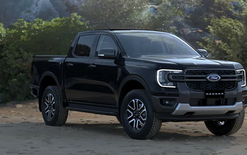Fleet renewal key to lower emissions

It is a challenging and exciting time to be in the automotive industry as the government’s framework for its clean car policies starts to phase in – and all the capabilities required to enable the change to low-emissions vehicles need to come together to keep pace with ambitions.
In amongst all the policy churn, it might be easy to forget that Kiwis are passionate about their cars, and we are passionate about delivering great vehicles, writes Ford NZ’s Simon Rutherford. They love them because their capabilities meet their needs and they enjoy the benefits they bring every day.
The government policy framework centres around two cornerstone policies.
The feebate, or clean car discount, is the first. A customer-facing scheme, it was launched with rebates on July 1, 2021. It changes from January 1, 2022, to expand the rebates on a sliding scale from just battery electric vehicles (BEVs) and plug-in hybrids (PHEVs) to other new vehicles that emit less than 146 grams of carbon dioxide (CO2) per kilometre. It will also introduce fees for vehicles that emit more than 192gCO2/km on the WLTP.
Then, later next year, the clean car standard is due to be introduced. That means distributors will be faced with a target-based system for importers. The standard targets an average of new cars entering fleet to be 105gCO2/km by 2025 versus the current average of about 171gCO2/km on the NEDC.
This represents a 39 per cent reduction in five years. Penalties are $50 per gram of CO2 on excess over the weighted manufacturer’s target for 2023 and 2024, rising to $75g/C02 from 2025.
Separate targets exist for cars and SUVs at 102g and commercials at 132g by 2025. The targets are currently NEDC-based and are being converted to WLTP to match the feebate measures.
The public is starting to understand the feebate scheme and how it impacts the price of the vehicles they choose but are largely unaware of the clean car standard, which may have a similar impact as the clean car discount in terms of pricing.
Ford NZ supports the government’s aim to reduce national CO2 emissions, improve air quality, increase sustainability and improve the accessibility of lower CO2 vehicles.
We believe we can be a significant contributor to achieving the goals, and that the most effective and immediate method of achieving this is through fleet renewal – replacing older more polluting vehicles with newer vehicles that achieve lower emissions using the latest technology.
The key debate right now is whether policymakers have got the balance of targets and timing right or not. We recognise this is a challenging space to get right and there’s no solution that satisfies all, so our focus is on the effectiveness of the policy.
There remains an opportunity to fine-tune the framework on targets and timing to ensure it is more effective and scalable in delivering against its objectives.
Left alone, it will have some undesired outcomes along the pathway and we have sympathy with vehicle owners who face fees when there are no realistic alternatives that meet their functional needs right now.
In a nutshell, we believe the framework is sound, but the pace of change is not in-tune with the reality of the start point in our market.
It risks a societal “us and them” reaction that could be avoided if target timing was simply adjusted in-line with the Climate Commission’s recommendations and technology availability in certain segments of the market.
We are now less than six months away from the proposed timing for the introduction of the full clean car discount. We will see expanded eligibility for rebates alongside the introduction of charges from January 1 if the proposed timing is held.
Differences in markets
Much of the policy framework we now see here in New Zealand is based on the European experience.
However, there are some key differences between our country and Europe that haven’t been accounted for in the pace of change.
And they support our view that it is the timing of targets and incentives that drive inequity, not the design of the policies themselves. These differences include:
• The market segmentation in New Zealand is very different from Europe, so current targets here represent a change curve that is significantly above other jurisdictions. This means an unprecedented rate of reduction is required within the nominated timeframe. This hasn’t been achieved in any other market in the world.
• In Europe, people mainly drive manual cars, which do offer lower CO2 emissions. Kiwis prefer and are mainly qualified to drive automatics. Manuals are usually cheaper to purchase, but New Zealanders do not value them, preferring to pay more for the functionality and capability of an automatic transmission.
• Fuel quality is a critical enabler of a low-emissions policy. New Zealand’s market fuel quality does not meet the same standards as those in Europe, which is delaying the introduction of some lower-emitting models due to the higher level of aromatics allowed in New Zealand fuel.
• The nature of our road network means low-output engines are not always fit for purpose or safe. Our geography is not comparative with the UK and EU where many journeys are on relatively flat motorways for which lower-output CO2 engines are fit for purpose.
• All-wheel drive (AWD) is highly desired for safety due to our roads. This is especially the case on the South Island, whereas in Europe 4WD or 2WD vehicles offer the capability required for usage. When it comes to commercials, for example, a far higher mix of vans, such as the Transit, are sold rather than utes. In fact, the Transit is the best-selling vehicle in the UK so far this year.
• The balance of our industry is different to international benchmarks and is heavily dependent on primary industries. For example, the Ranger is required in four-by-four mode for farming, forestry, towing and rural activities. Such capability is a functional requirement for certain types of work and these vehicles support key contributors to the national economy.
Realistic targets needed
We are all looking for scalable change, and there is a trade-off between impact and target setting. If targets are unrealistic, then so will be benefits of scale.
There should be recognition that most new vehicles sold today are already much cleaner than those in the fleet – unrealistic targets will hinder fleet renewal and limit and or restrict this contribution. If fleet renewal stalls, then so will progress towards the goals.
Clearly, there is tension between the cost-of-ownership objectives, fit-for-purpose requirements, affordability and product availability in the pursuit of the targeted CO2 reductions that need to be recognised.
We, alongside our fellow industry members, made the point that the timeframe of any proposed policy implementation needed to be equitable and in-step with the timing for scaled new propulsion technology adoption across all market segments and not ahead of it. Right now, it is ahead of it in key segments and overall.
As such, although we support the government’s policy framework, we are not supportive of the timeframe and the pull-forward of standard targets from 2028 to 2025.
This is because we cannot achieve the 39 per cent reduction in what is effectively four years from today and support our customers with what they need.
It isn’t clear on what basis the pull-forward decision was made, but it is clear there were some false assumptions on the availability of electrified products coming earlier than they are.
We are, therefore, concerned that clean car fees next year on some commercials will penalise people who have no workable and cost-effective alternatives at this point.
The policy framework also needs to start to address vehicles already in the fleet and we can’t just get there by managing what enters the fleet or we will potentially just go backwards.
We also need a tailpipe test and a scrappage scheme because these have been components of acceleration in other markets. In the interim, we will continue to offer what we can as soon as we can.
What Ford is doing
Ford of Europe is five years into its electrification journey, which is why New Zealand has been able to benefit from the limited availability of vehicles such as the Transit and Tourneo PHEVs, the Escape PHEV, which is available to order now, and the forthcoming all-electric Transit Cargo in right-hand drive (RHD).
Ford US recently launched the Mustang Mach E and F150 Lightning BEVs, which unfortunately we do not yet have access to due to capacity limitations and LHD.
Ford Motor Company continues to invest significantly in no and low-emissions vehicle mobility solutions, and, over time, we look forward to introducing an expanded range of fully capable electric and PHEVs to Kiwis.
It’s our belief that – as importers and manufacturers – we have as much responsibility as the government to help consumers understand the clean car programme, its impact and what their vehicle options and costs are going to be, as well as to provide solutions when we can because that’s the competitive nature of the industry.
Many Ford models, for example, will fit into the government’s proposed “no fee” band or a moderately fee low band scheduled for introduction next year, including the often maligned but increasingly popular ute.
The relatively low CO2 emissions of our two-litre, bi-turbo Ranger with its 10-speed automatic transmission will translate into being at the lighter end of the penalties in the utility segment in 2022, but will still deliver more power and torque than the 3.2-litre and six-speed transmission.
This is a longer version of Simon Rutherford’s guest editorial in the August issue of Autofile magazine





